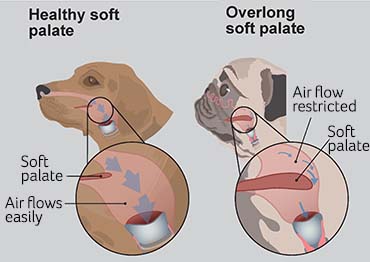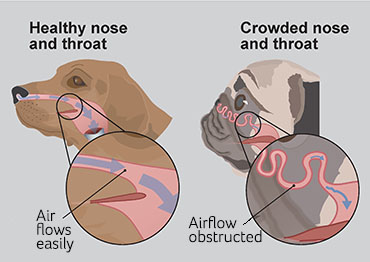Brachycephalic Obstructive Airway Syndrome (BOAS)
What is it?
Brachycephalic Obstructive Airway Syndrome (BOAS) is a breed related disorder that significantly compromises the way pets breathe.
Brachy means shortened and Cephalic means head, so animals affected are “flat face” breeds. These dogs have skull bones that are shortened in length, giving the face and nose a pushed-in appearance.
Due to the shorter bones of the face and nose, the anatomy and relationship with the other soft tissue structures are altered; some of these changes can cause physical problems for the affected dog.


What are the Predisposed Breeds
- English Bulldog
- French Bulldog
- Bull Mastiffs
- Boston Terrier
- Pug
- Boxer
- Pekingese
- Shih-tzu
- Chinese Shar-Pei
- Chow Chow
- Lhasa Apso.
What to look for
- Noisy breathing, especially on inhalation (snorting).
- Snoring while sleeping.
- Increased breathing effort.
- Exercise intolerance (tiring easily).
- Retching or gagging, especially when swallowing.
- Nasal discharge (stenotic nares).
- Blue tongue and gums (from lack of oxygen).
- Fainting or collapse (loss of consciousness) – can be fatal.
- Generally worse after exercise, excitement, excessive heat/humidity.
- Signs worsen with obesity.
How we can help
We can diagnose stenotic nares on a routine physical exam, and suspect elongated soft palate and everted saccules based on clinical signs and history, but we can only diagnose and assess severity of the latter conditions on a sedated dog, as dogs rarely allow us to look at the back of their throats for an extended period of time, and often their tongue is in the way.
A sedated upper airway examination will allow us to accurately diagnose and come up with an appropriate treatment plan (which will likely include surgery) to allow your dog to breathe easier.
What you can do
How to help minimise breathing issues at home?
- Limit expose to heat and humidity – inside in air conditioning on hot days.
- Make sure exercise is not too strenuous – indoors or at cooler times of day.
- Use a harness instead of a neck collar.
- Teach your dog to have self-control, keep them calm, train them to settle down.
More information
Find more information in these online resources:
https://www.vet.cam.ac.uk/boas/about-boas/
https://www.acvs.org/small-animal/brachycephalic-syndrome/
If you plan to fly with your snub nosed dog, please read our Pet Travel section on and make sure to book an appointment for a Fit To Fly assessment
Flying a Snub-Nosed Pet?
If you plan to fly your snub nosed pet, also read our Pet Travel section and make sure to book an appointment for a Fit To Fly assessment

